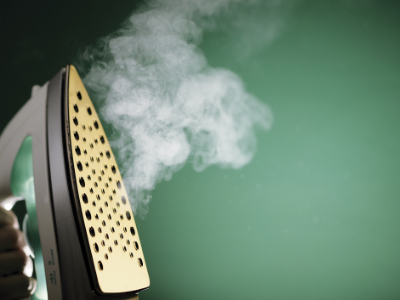How to clean a sticky iron
* We sometimes use affiliate links, so we may receive a commission, at no cost to you, if you make a purchase through a link. Check our disclosure for more info.
Wondering how to clean a sticky iron?
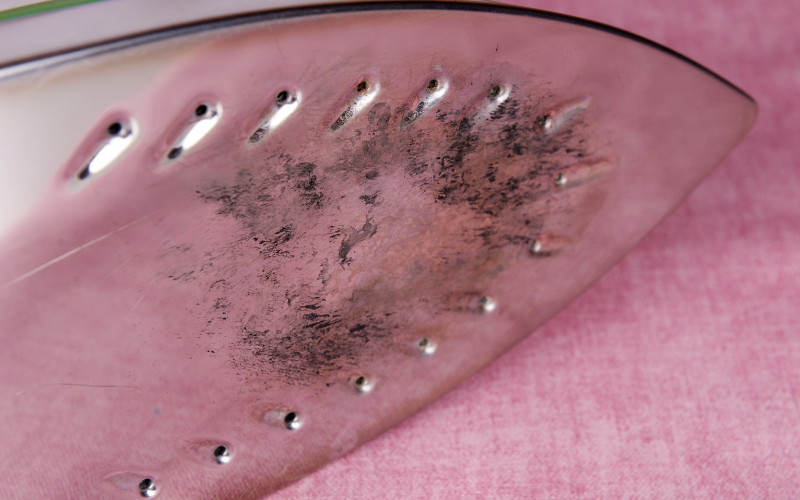
Everyone’s been there, the day you’ve accidentally had the iron on a little too high and melted your favourite top. It’s a nightmare. Not only have you got a hole in that one top you loved, but you now need to find a way to clean a sticky iron.
Ways to clean a sticky iron
- Water & salt
- Baking soda
- Baking soda & vinegar
- Baby powder
- Drying sheets
- Toothpaste
- Nail varnish remover
When it’s time to get gunk off irons, it’s likely the iron has come into contact with fabrics and materials that have a low melting point. These materials are generally synthetic fibres such as: nylon, latex, elastane, polyester, acrylic and spandex. It’s another reason these types of fabric are normally advised against use in the drying machine; their fibres will melt, shrink or distort.
And, it may seem impossible, much like many sticky things out there, but here at Laundry Life, we’ve got some tips for you. 7, to be exact:
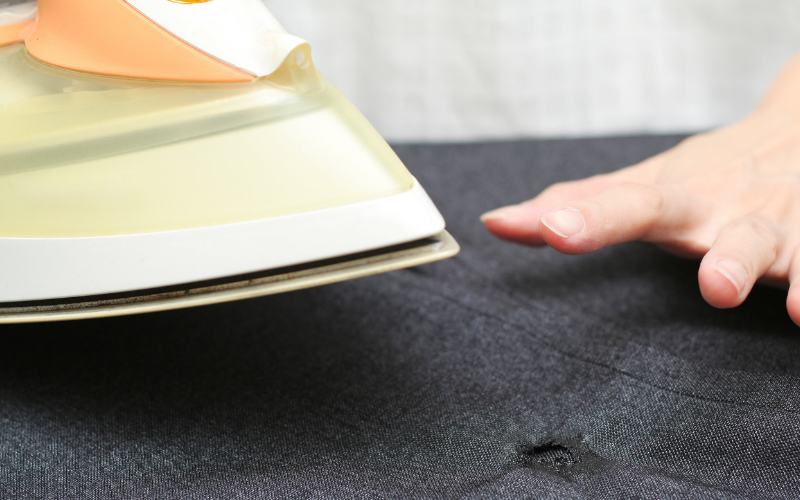
How to clean an iron with water and Salt
The first port of call to clean a sticky iron will always be to pull out the water. While making sure the iron is still warm (but not hot enough to burn the skin), take a soft sponge and some warm water.
Rub in circular motions along the base to remove melted polyester from an iron. If the melt is new, the fabric should still be soft enough to prise away from the iron plate.
However, if it needs a little extra help, try to stir a teaspoon of salt into the water or onto the rag. The granules will provide the perfect soft abrasion to help with any hardened areas.
How to clean an iron with baking soda
Next on the list is trying out dry baking soda. For this method, you’ll need your iron to be on a low heat and you’ll need an old rag on a hard surface.
Kitchen countertops can be great for this method because materials such as granite can take high heat without staining (but do check with the type of countertop you have; it may be better to place a large chopping board down).
Pour the baking soda onto the rag on top of your hard surface. Then, with the iron on low heat, ‘iron’ the rag. Baking soda is a fantastic trick because it bubbles to create CO2 when in contact with heat and humidity such as with an iron. These bubbles – as well as the natural abrasion – help to get gunk off irons.
How to clean an iron with baking soda and vinegar
If the baking soda isn’t cutting it alone (and you have the nose for it) you can add white vinegar to the mix.
Simply mix a half and half solution of water and white vinegar and pour it into the water reservoir of your iron.
Vinegar is a natural acid formed by the fermentation of ethanol and bacteria. Meaning it will fight against hard stains and smells pretty much anywhere in your home. Then, when it comes into contact with the baking soda, both of their roles multiply and their ability to remove melted polyester from an iron strengthens.
When your water reservoir is full to the line, turn your iron onto a low heat. While it is heating, follow the steps for just using baking soda. Then, while you are ironing the rag, press the steamer button to speed up the process.
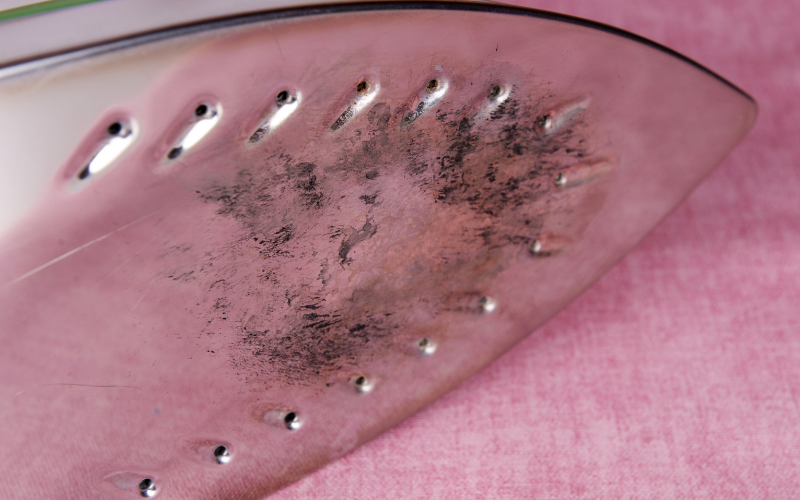
How to clean an iron with baby Power
If, instead, you’re looking to use something you may already have laying around your home as a temporary measure to get gunk off irons, you can use baby powder.
As a natural drying agent, it can remove the moisture from a substance that allows it to be sticky. To do this, make sure your iron is turned off and cold to the touch. Then, pour some baby powder onto an old rag and gently rub into the sticky areas.
While this may not clean a sticky iron, it removes the sticky layer. Then, all you’ll need to do is find the other ingredients that get gunk off irons at a later date.
Another reason to do this is that it can immediately diffuse the environment to make it safe for little ones. Melting materials can give off harmful gases when breathed in. So, creating this temporary barrier with baby power can buy you time to get the right ingredients and spend time on cleaning after the little ones have gone to sleep.
How to clean an iron with dryer sheets
There are multiple brands out there to choose from, but they all do the same job to clean a sticky iron.
Dryer sheets are made up of a non-woven material. Then, they are doused in various substances including fragrance and softening agents. Their main purpose is to keep clothes soft and fresh, but this softening agent also helps to breakdown sticky residues and remove melted polyester from an iron.
So, you’ll need to turn your iron onto a low heat and make sure that the steaming functions are turned off. Then, place your dryer sheets on top of an old towel on a hard flat surface.
When the iron is ready, gently wipe the iron onto the dryer sheet making sure to only ever go in one direction. I.e., place the iron on the dryer sheet, pull towards yourself, lift the iron up, place the iron back down in the starting position and so on. Repeat to get gunk off irons.
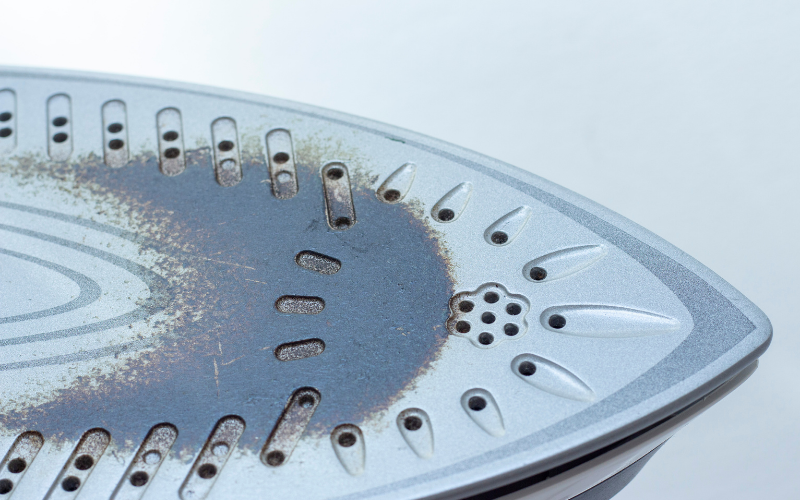
How to clean an iron with toothpaste
Next in this venture of how to clean a sticky iron is using toothpaste. There are a few main ingredients within toothpaste that you may already know of such as fluoride. But, it is the calcium carbonate and sodium lauryl sulphate that will help us remove melted polyester from an iron.
Calcium carbonate has a light abrasive texture that helps to remove debris and surface stains.
Sodium lauryl sulphate, on the other hand, creates a nice bubbling effect when worked, meaning it can help pass air through pockets of the sticky residue.
When your iron is turned off and cold to the touch, you can either apply a small amount of toothpaste to an old rag or to a toothbrush. However, if your iron has a coating of Teflon or other non-stick material (which never works anyway), then avoid the toothbrush. Run in circular motions to get gunk of irons.
How to clean an iron with nail varnish remover
Finally, it’s the turn of acetone or nail varnish remover. As a natural acid it melts much of the surfaces it comes into contact with. Meaning it is great for removing nail varnish, stains and sticky residue.
However, this will depend on the surface. It will work very well on glass, metal and stone but will easily destroy wooden surfaces or painted areas. The same goes for Teflon.
If your appliance has a Teflon coating, don’t use this method to clean a sticky iron; you will damage the Teflon.
To use this method on a metal surface, apply some nail varnish remover to a cotton pad or old rag and gently rub onto a cold iron. Keep rubbing to remove melted polyester from an iron!
Iron cleaning products
- Easy & handy to use each time you finish ironing to maintain the soleplate makes irons glide - removes melted fusible
- Can be used to remove melted webs, fusible, iron-on interfacings, trims, burned-on synthetics & coatings caused by excess starch & detergent build-up makes iron glide easier so ironing seems faster
- Simple, quick and effective
- Specifically manufactured to increase the performance, functionality and life-span of your machine
- 28g x 1 tube
- Easy & handy to use each time you finish ironing to maintain the soleplate makes irons glide - removes melted fusible
- Can be used to remove melted webs, fusible, iron-on interfacings, trims, burned-on synthetics & coatings caused by excess starch & detergent build-up makes iron glide easier so ironing seems faster
- Simple, quick and effective
- Specifically manufactured to increase the performance, functionality and life-span of your machine
- 28g x 1 tube
- Faultless Hot Iron Cleaner, 28 g
- product type: HOME
- Brand: FAULTLESS
- Size: 28 g






